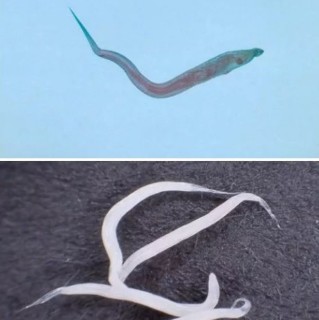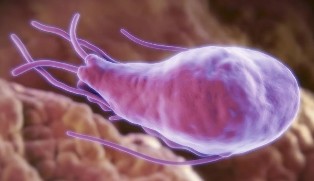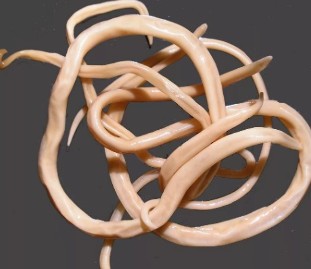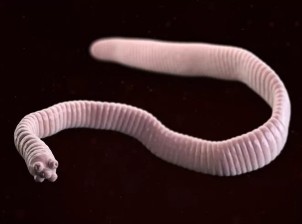Types of parasites in the human body is exceptionally diverse. Their number, together with many-cellular and protozoan cysts, viruses, bacteria and fungi, the parasites at the expense of the human organism, although in the Tradition of medical viruses and bacteria, not as mere parasites.

In the human body, different types of parasites are not localized only in the intestine, as is commonly believed, but also in many other organs: blood, tissue muscles, in the joints, in the brain (the brain and spinal cord) and also in the eyes.
Particularly vulnerable to the effects of such internal organs as the digestive tract, liver, lungs, heart.
The stay parasites in the human body is far from harmless. Their harmful effect consists in the fact that they absorb nutrients for a large part of the food, without the full functioning of the body impossible.
The imbalance is also the General intoxication of an organism of the people, by the toxins, the parasites, which could lead to the development of a number of diseases to malignant. Often diseases that take by parasites, chronic.
The particular danger is that a parasitic diseases cause symptoms, which is typical for other, the most common intestinal infections, thus, is of great importance to the timely differential diagnosis for the determination of the type of parasites and the development of adequate therapeutic tactics.
Types of parasites of human beings in General can be divided into two large groups:
- ectoparasite, parasite on the surface of the body and of the blood of the people fed (bugs, fleas, lice, mites); serve as vectors for the pathogens of such infections, such as encephalitis, typhoid, anthrax, etc.;
- endopara site, parasites in the internal organs and cause serious diseases; these include protozoa (Giardia, amoeba, Trichomonas, Toxoplasma) and helminths – parasitic worms (worms) include.
Classification of parasites

We consider the main types of endoparasites of the people. The many appearance of them can be seen only under the microscope, and some, particularly from the group of helminths, amazing for its size. We start with the simplest:
- Giardia along with dysbiosis are also the cause of hypovitaminosis, anemia, and General intoxication.
- Toxoplasma astound the brain, eyes, heart muscle, the nervous system, but they were a special danger for pregnant women because of the risk of fetal death or severity of his low.
- Amoebae are able to cause the amebnuju dysentery, amoebic encephalitis and other dangerous diseases.
- Trichomonads are sources of infectious diseases of the genitourinary system.
The most common parasites
Among the most common endopara site, helminths (worms), which, according to various data, has infected more than 80% of the population of the planet certainly.
A large number of these parasites can be divided into the main types:
- Nematodes – nematodes (roundworms, pinworms, trichina, whip worm, etc.);
- cestody tape-worms (lentetsy, pigs and cattle tsepen, Echinococcus, etc.);
- trematody – worms-flukes (liver, blood, lung and tape worms in the gut).
Sometimes you can be divided on the General classification, after the people are all kinds of parasites in:
- Intestinal, parasites in the intestine;
- Tissue, localized in other organs and tissues.
However, most of the helminths in different stages of their life cycle, and fabric, and intestinal Phase of development with the corresponding symptoms.
You are viewing a brief description of the most common types of worms.
Round Worms (Nematodes)
- Roundworm – the most common round worms with a length of 20 to 40 cm, parasitize in the small intestine, but migrate in the human body, by the circulatory and respiratory organs. Together with the intestine, this parasite, bladder, heart and lungs are found in the liver and bile. Common Symptom of Ascariasis – an allergic reaction.
- Pinworms – small worms, up to 1 cm, the intestine and lead to enterobiasis work with the disease, gastro-intestinal, fatigue, sleep disturbances, etc. a Characteristic Symptom of a pinworm itching in the area of the Anus, where they lay eggs.
- Trichinella – this is a microscopically small worms (the size of only a few millimeters) lead to severe diseases – trichinosis, which if left untreated, lead to death. Adult species live in the human body, in the muscles (respiratory, face, etc.), causing muscle pain, fever, swelling, allergic skin rashes.
- Whip – small worms (length up to 4.5 cm, with the front part of the body

The larvae cause trichocephalosis with diarrhea, acute abdominal pain and other symptoms of appendicitis. Due to intoxication of the organism, an anemia develops.
Tape-worms (cestody)
- Broad tape-worm, the length of a body reaches 10 m, leads to the development of difillobotrioza is checked with nausea, weakness, vomiting, unstable chair, asthenia, and anemia.
- Swine tsepen has a length of 3 to 8 m, parasitized mainly in the small intestine and causes two diseases: taeniasis with dyspeptic, asthenoneurotic and abdominal syndromes and cysticercosis with intoxication, and intestinal, allergies, and respiratory syndromes. Depending on the localization tsistitserki affects the muscles, brain, heart, eyes, etc.
- Bullish tsepen, whose length can be up to 18 m, caused teniarinhoze and is considered to be one of the most dangerous types of tape worms. If you do not dehelmintization, he can old life in the human body for up to 18-20 years! Localized in the large intestine, causes severe poisoning products, as well as diarrhea, nausea, vomiting, abdominal pain, anemia, allergic reactions, and problems with the nervous system.
- Dwarfish tsepen a length of only 1.5-5 cm source hymenolepiasis with dyspeptic, armbar, and asthenic-neurotic syndrome, from which they are suffering, especially of digestive and nervous System of the body, as well as the liver.
- Echinococcus is considered to be the small tape worm – its length is only 2.5 to 8, rarely 9 mm, but infect it has threatening consequences in the Form of lesions of the liver and the lung, where the cysts and tumors, dysfunction of these organs.

Worms-Flukes (Trematodes)
- Hepatic fluke, liver or Fluke shape is reminiscent of a leaf is 30-50 mm long and 8-13 mm wide, has suction cups. It damages the shell of the liver and bile ducts clog, is able to completely block the flow of bile. Can addiction cirrhosis, yellow, and liver cancer.
- Cats (Siberian) fluke, or cat's dvuustka, flat worm, a length of 4-13 mm. Localization – the ducts of the gallbladder, liver and pancreas. Causes opisthorchiasis with the development of Gastritis, ulcer, pancreatitis, cholecystitis until the cancer of the liver, which can lead to death.
- Pulmonary fluke has an egg-shape, red-brown body with small thorns, with a length of 7.5 to 12 mm and a width of 4-8 mm. The lungs, inflammation affecting, pleural effusion, focal fibrosis, and lung cancer. During penetration in the brain encephalitis and meningoencephalitis caused.
- Schistosoma (blood flukes) – dioecious worms in the size of 1-2 cm, the eggs cause an enlarged liver, spleen, and lymph nodes, formation of polyps in the bowel, diarrhea, granulomatous inflammation, and cancer of the urinary bladder.
Sources of contamination

Helminthiasis can lead to numerous health problems, which the life to 15-25 years. To identify many of the parasites is extremely difficult. They can be anywhere - in the blood, intestines, lungs, heart, brain. Symptoms of the infestation of worms can be confused with SARS, diseases of the digestive tract and other. The main error in such cases the delay! If you have a suspicion of the presence of parasites, then they consult a specialist. If you are talking about the drugs and self-Service-treatment against the most common worms (roundworms, pinworms, tapeworms) suitable antiparasitic complex.
Helminthiasis, like other intestinal disorders, most of the "disease of dirty hands", which causes the penetration of the eggs and larvae of worms in the human body:
- if not wash hands after the toilet and before eating;
- do not wash vegetables, fruit and herbs, which are consumed in raw Form;
- not on meat and fish sufficiently or not heat-treated;
- consumption incorrectly salted fish and fat;
- food preparations can be accessible to flies and cockroaches;
- use of faeces as a fertiliser on allotment gardens;
- Bathe in non-designated waters;
- in contact with stray animals.

Also, your pet can also be caused by viruses, such as worms, because often animals serve as intermediate hosts for helminths, and the host is the human.
Methods of struggle
- To vaccinate from an early age children the habit of washing hands. You need to do it more often, because they constantly potters in the Sand, soil, puddles, where the most favorable conditions for the eggs and larvae of the parasites, and in contact with the house and street animals.
- In the case of occurrence of complaints of any worm diseases cannot be ruled out, therefore, it is recommended to make the appropriate Tests for parasites for the determination of the specific type of worm (for most of them there are medications.
- If parasites are a family discovered in a member of drugs for Helminthiasis all should.
- Folk medicine, there are many ways on how to get rid of worms, and you give a good effect.
- Not left open prepared meals, bread, pastries, etc., to the flies or cockroaches are the carriers of the eggs – not had them on the products.
- Note carefully the temperature in the kitchen: meat and fish, which often have worm eggs, well prowariwat/fry thoroughly/baking.
- Well-vegetables, fruits, herbs, which are consumed in raw Form, rinse under running water.
- Regular deworming of domestic animals.
- The use of faeces as a fertiliser on their allotment gardens.
- When traveling in exotic countries to be very careful about the dishes of the local cuisine, especially on the road, – there is no guarantee that you will not not be be measured with you hook something less exotic.








































